Bowl of Hygieia
Bowl of Hygieia is one of the symbols of pharmacy, and along with the Rod of Asclepius it is one of the most ancient and important symbols related to medicine in western countries. Hygieia was the Greek goddess of Health hygiene, and the associate, wife, or daughter of Asclepius. Asclepius' symbol is his rod, with a snake twined around it; correspondingly, Hygieia's symbol is a cup or chalice with a snake twined around its stem. Hygieia was also invoked, along with her father Asclepius, and Panacea in the original Hippocratic Oath.
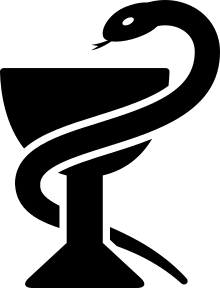
Usage of symbol by pharmaceutical associations
The bowl of Hygieia has been used as a symbol of the pharmacy profession at least as far back as 1796, when it was used on a coin minted for the Parisian Society of Pharmacy.[1] It has since been adopted by many more pharmaceutical associations worldwide, such as the American Pharmacists Association,[2] the Canadian Pharmacists Association,[3] the Pharmaceutical Society of Australia,[4] and the Doctor of pharmacy Association,[5] Conseil de l'Ordre des Pharmaciens in France[6] (where is written in law with another symbol, the green Greek cross).[7]
The bowl of Hygieia is a common symbol on signs outside of pharmacies in Europe. A mortar and pestle is a more common symbol in the United States.
- Typical pharmacy logos featuring the bowl of Hygieia from different countries
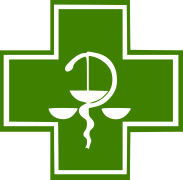 All of Europe
All of Europe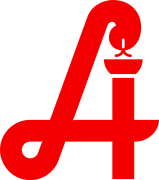 Austria
Austria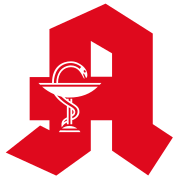 Germany
Germany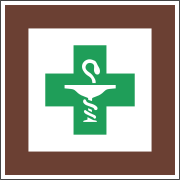 Hungary
Hungary
References
| Wikimedia Commons has media related to Bowl of Hygieia. |
- "History of the Bowl of Hygeia award | Drug Topics". Drugtopics.modernmedicine.com. 2002-10-07. Retrieved 2013-04-26.
- "Bowl of Hygeia Wyeth.com". Web.archive.org. 2009-04-16. Archived from the original on April 16, 2009. Retrieved 2013-04-26.
- "Home - CPhA". Pharmacists.ca. Retrieved 2013-04-26.
- "Pharmaceutical Society of Australia". Pharmaceutical Society of Australia.
- "Doctor of Pharmacy Association -".
- "La protection de la croix verte et du caducée - Nos missions - Ordre National des Pharmaciens" (in French). Ordre.pharmacien.fr. 2012-06-14. Retrieved 2013-04-26.
- "Code de la santé publique - Article R4235-53" (in French). Legifrance. 2004-07-29. Retrieved 2013-04-26.